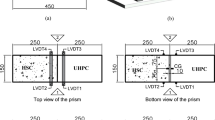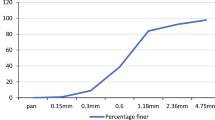Abstract
Steel–concrete–steel (SCS) sandwich composite structure is a relative new type of system that combines the advantages of steel and reinforced concrete structure. Due to its excellent strength to cost performance, it exhibits versatile potential applications in building and offshore constructions. In order to reduce the self-weight of the structure and achieve composite action between the steel and concrete, ultra-lightweight cement composite and novel shear connectors have been developed and applied in the SCS sandwich composite structures, respectively. Meanwhile, the development of design guidelines lags behind the innovation of the structure. In this paper, experimental studies on SCS sandwich composite beams with different types of concretes and novel shear connectors are presented. This is followed by the development of analytical model to predict the ultimate strength of the SCS sandwich composite beams. Finally, the proposed analytical model is verified against the results from a series of beams tests which include Bi-steel sandwich beams, double skin beams, sandwich beams with J-hook connectors, angle connectors, and cable connectors. Through the analysis and verification, new methods to predict the ultimate strength of SCS sandwich composite beams are recommended for design purposes.



























Similar content being viewed by others

References
Liew JYR, Sohel KMA (2009) Lightweight steel–concrete–steel sandwich system with J-hook connectors. Eng Struct 31(5):1166–1178
Liew JYR, Sohel KMA, Koh CG (2009) Impact tests on steel–concrete–steel sandwich beams with lightweight concrete core. Eng Struct 31(9):2045–2059
Dai XX, Liew JYR (2010) Fatigue performance of lightweight steel–concrete–steel sandwich systems. J Constr Steel Res 66(2):256–276
Sohel KMA, Liew JYR (2011) Steel–concrete–steel sandwich slabs with lightweight core-static performance. Eng Struct 33(3):981–992
Bowerman H, Coyle N, Chapman JC (2002) An innovative steel/concrete construction system. Struct Eng 80(20):33–38
Xie M, Foundoukos N, Chapman JC (2007) Static tests on steel–concrete–steel sandwich beams. J Constr Steel Res 63(6):735–750
Zhao XL, Han LH (2006) Double skin composite construction. Prog Struct Eng Mater 8(3):93–102
Subedi NK, Coyle NR (2002) Improving the strength of fully composite steel–concrete–steel beam elements by increased surface roughness: an experimental study. Eng Struct 24(10):1349–1355
Montague P (1975) A simple composite construction for cylindrical shells subjected to external pressure. J Mech Eng Sci 17(2):105–113
Solomon SK, Smith DW, Cusens AR (1976) Flexural tests of steel–concrete–steel sandwiches. Mag Concr Res 28(94):13–20
Oduyemi TOS, Wright HD (1989) An experimental investigation into the behavior of double skin sandwich beams. J Constr Steel Res 14(3):197–220
Malek N, Machida A, Mutsuyoshi H, Makabe T (1993) Steel–concrete sandwich members without shear reinforcement. Trans Jpn Concr Inst 15(2):1279–1284
Foundoukos N (2005) Behaviour and design of steel–concrete–steel sandwich construction. PhD thesis, Department of Civil and Environmental Engineering, University of London
Liew JYR, Wang TY, Sohel KMA (2008) Tensile capacity of short anchor bolts and welded sandwich composite structures. US Provisional Patent 61/047, 130
Leekitwattana M, Boyd SW, Shenoi RA (2011) Evaluation of the transverse shear stiffness of a steel bi-directional corrugated-strip-core sandwich beam. J Constr Steel Res 67(2):248–254
Kim SH, Choi KT, Park SJ, Park SM, Jung CY (2013) Experimental shear resistance evaluation of Y-type perfobond rib shear connector. J Constr Steel Res 82:1–18
Ollgaard JG, Slutter RG, Fisher JW (1971) Shear strength of stud connectors in lightweight and normal-weight concrete. Eng J AISC 8(2):55–64
Shendy ME (1991) A comparative study of LECA concrete sandwich beams with and without core reinforcement. Cement Concr Compos 13(2):143–149
Bergan PG, Bakken K (2005) Sandwich design: a solution for marine structures. In: Proceedings of the international conference on computational methods in marine engineering. Eccomas Marine, pp 27–29
Chia KS, Zhang MH, Liew JYR (2011) High-strength ultra lightweight cement composite–material properties. In: Proceedings of 9th international symposium on high performance concrete design, verification & utilization, Rotorua, New Zealand, 9–11 Aug 2011
Weitzenböck JR, Grafton T (2010) Assessment of the INCA steel–concrete–steel sandwich technology—a public report. DNV, Det Norske Veritas, NO-1322 Høvik, Norway
Grafton TJ, Weitzenböck JR (2011) Steel–concrete–steel sandwich structures in ship and offshore engineering. In: Guedes Soares C, Fricke W (eds) Advances in marine structures. Taylor & Francis Group, London, pp 549–558
British Standard Institution (2000) BS5950-1: structural use of steelwork in building—part 1: code of practice for design-rolled and welded sections. BSI, London
Eurocode 4 (2004) Design of composite steel and concrete structures—part 1.1: general rules and rules for buildings. BS EN 1994-1-1
AISC (2010) Specification for structural steel buildings. AISC-360-10, American Institute of Steel Construction, Chicago
Yan JB, Liew JYR, Sohel KMA, Zhang MH (2013) Push-out tests on J-hook connectors in steel–concrete–steel sandwich structure. Mater Struct. doi:10.1617/s11527-013-0145-y
American Concrete Institute 318 (ACI) (2008) Building code requirements for structural concrete (ACI 318-08) and commentary (ACI 318R-08). American Concrete Institute, Farmington Hills
Eurocode 2 (2004) Design of concrete structures—part 1-1: general rules and rules for buildings. BS EN 1992-1-1
Eurocode 3 (2005) Design of steel structures—part 1-1: general rules and rules for buildings. BS EN 1993-1-1
Narayanan R, Roberts TM, Naji FJ (1994) Design guide for steel–concrete–steel sandwich construction, Volume 1: general principles and rules for basic elements. The Steel Construction Institute, Ascot, Berkshire, UK
Roberts TM, Edwards DN, Narayanan R (1996) Testing and analysis of steel–concrete–steel sandwich beams. J Constr Steel Res 38(3):257–279
McKinley B, Boswell LF (2002) Behaviour of double skin composite construction. J Constr Steel Res 58(10):1347–1359
Acknowledgments
The research described herein was funded by the Maritime and Port Authority of Singapore, and supported by the American Bureau of Shipping (ABS) and National University of Singapore under research project titled “Curved steel–concrete–steel sandwich composite for Arctic region” (Project No. R-302-501-002-490).
Author information
Authors and Affiliations
Corresponding author
Rights and permissions
About this article
Cite this article
Yan, JB., Liew, J.Y.R., Zhang, MH. et al. Experimental and analytical study on ultimate strength behavior of steel–concrete–steel sandwich composite beam structures. Mater Struct 48, 1523–1544 (2015). https://doi.org/10.1617/s11527-014-0252-4
Received:
Accepted:
Published:
Issue Date:
DOI: https://doi.org/10.1617/s11527-014-0252-4



